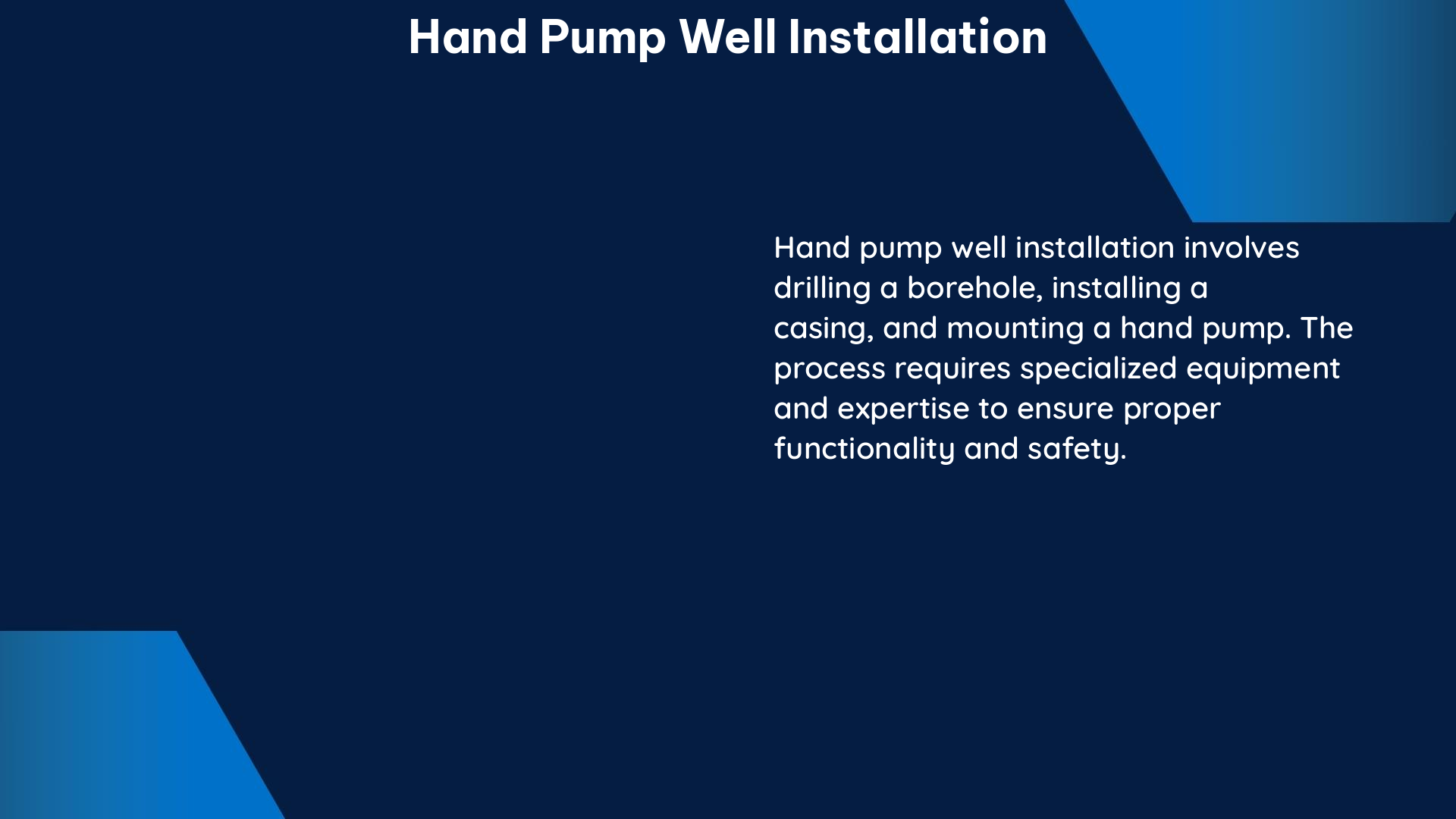Hand pump well installation is a critical process that requires meticulous planning and execution to ensure the functionality and sustainability of the water source. This comprehensive guide will delve into the intricate details of hand pump well installation, covering the depth of the well, pump selection, management team, and essential tools required for a successful project.
Determining the Depth of the Well
The depth of the well is a crucial factor in hand pump well installation. According to a study conducted in Ghana, the average water table depth ranges between 50-200 feet. However, it is possible to install a hand-drawn well pipe deeper by “hammering” it down, as demonstrated in a video from Permies.com. In this video, a 520-foot deep well is successfully installed with a Simple Pump, showcasing the versatility of hand pump technology.
To determine the optimal well depth for your project, consider the following factors:
-
Groundwater Level: Conduct a thorough assessment of the local groundwater level to ensure the well can reliably access a sustainable water source. This may involve consulting with local hydrogeologists or conducting on-site surveys.
-
Soil Composition: Analyze the soil composition at the proposed well site to identify any potential challenges, such as hard rock layers or unstable soil conditions, that may impact the well depth and installation process.
-
Water Quality: Assess the water quality at different depths to ensure the well can provide safe, potable water for the community. This may involve testing for contaminants, pH levels, and other water quality parameters.
-
Community Needs: Consider the water usage requirements of the community, including the number of households, livestock, and any agricultural or industrial needs, to determine the appropriate well depth and pump capacity.
Selecting the Appropriate Hand Pump

The choice of hand pump is crucial for the functionality and sustainability of the water source. The study in Ghana found that the majority of handpump water sources were Modified India Mark II pumps (64.7%), followed by Afridev pumps (19.1%), Nira pumps (3.4%), and Vergnet pumps (0.7%).
When selecting a hand pump, consider the following factors:
-
Pump Type: Evaluate the different pump types, such as the India Mark II, Afridev, Nira, and Vergnet, and their suitability for the well depth, water quality, and community needs.
-
Pump Capacity: Ensure the pump’s capacity can meet the water demand of the community, taking into account peak usage and future growth.
-
Durability and Maintenance: Choose a pump that is known for its durability and ease of maintenance, reducing the frequency of repairs and ensuring long-term functionality.
-
Local Availability and Support: Select a pump that is readily available in the local market and has a reliable network of suppliers and technicians for maintenance and repairs.
Assembling the Management Team
The management team plays a crucial role in the functionality and sustainability of the hand pump well. The study in Ghana found that management variables, such as the presence and quality of the management team, significantly affect the functionality of the water sources.
When assembling the management team, consider the following roles and responsibilities:
-
Community Engagement: Involve the local community in the decision-making process, ensuring their needs and concerns are addressed throughout the project.
-
Technical Expertise: Ensure the team includes individuals with technical expertise in well drilling, pump installation, and maintenance, such as experienced plumbers or water engineers.
-
Financial Management: Appoint individuals responsible for managing the financial aspects of the project, including budgeting, tariff collection, and maintenance fund allocation.
-
Maintenance and Repair: Establish a dedicated team responsible for the regular maintenance and prompt repair of the hand pump, ensuring its continuous operation.
-
Monitoring and Evaluation: Implement a system to regularly monitor the functionality of the hand pump and evaluate the overall performance of the management team.
Gathering the Necessary Tools
Having all the necessary tools before starting the installation process is crucial to avoid making multiple trips and delays. For example, when installing the Simple Pump, an expansion coupling is required, and having the right size Allen wrench and level is essential to ensure a proper installation.
The essential tools for hand pump well installation may include, but are not limited to:
| Tool | Purpose |
|---|---|
| Drill Bits | Drilling the well and creating the necessary holes for the pump installation |
| Pipe Wrenches | Tightening and loosening the well casing and pump components |
| Pliers | Gripping and manipulating small parts during the installation process |
| Allen Wrenches | Tightening and loosening the expansion coupling and other pump components |
| Level | Ensuring the proper alignment and leveling of the pump during installation |
| Torque Wrench | Applying the correct amount of torque to the pump components for a secure installation |
| Expansion Coupling | Connecting the well casing to the pump during the installation process |
| Rope/Pulley System | Lowering and raising the pump components into the well |
Ensuring that all these tools are available and in good working condition before the installation process begins can significantly improve the efficiency and success of the hand pump well project.
References:
- https://permies.com/t/157651/deep-install-water-hand-pump
- https://www.ncbi.nlm.nih.gov/pmc/articles/PMC5019267/
- https://www.youtube.com/watch?v=UWYcJZZ-ldw

The lambdageeks.com Core SME Team is a group of experienced subject matter experts from diverse scientific and technical fields including Physics, Chemistry, Technology,Electronics & Electrical Engineering, Automotive, Mechanical Engineering. Our team collaborates to create high-quality, well-researched articles on a wide range of science and technology topics for the lambdageeks.com website.
All Our Senior SME are having more than 7 Years of experience in the respective fields . They are either Working Industry Professionals or assocaited With different Universities. Refer Our Authors Page to get to know About our Core SMEs.